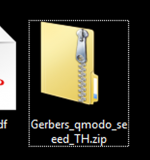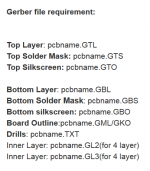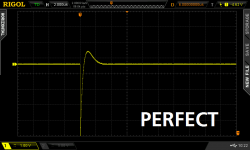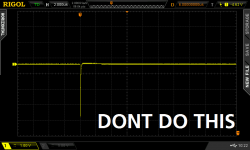I've attached the Gerber files and a Bill of Materials for a thru-hole implementation of the Quasimodo idea. They are in a .zip archive, attached to this posting. So far, I have built two of these boards and they work quite nicely. A component side plot is displayed in red (below), back side plot is green.
If anyone wants to organize a group buy for a batch of these boards, and/or boards + kits of parts, please do so with my blessings. The BOM and the CAD files are right here.
Edit The attachment here is incomplete. For the full attachment, see post #58"
Hi,
Thanks for the work to make this project.
I have access to an old circuit board plotter to make a board.
First I have to import the files to a program called Circuit Cam to make a board file for the plotter.
Could you please tell me what these extensions standing for, or the name of the PCB program you used to make your board?
.GBL
.GBO
.GBS
.GML
.GTL
.GTO
.GTS
.TEX
I guess .GBL is the bottom layer, and .GTL is the top layer, but I would least need the wheel file, the drill tool and the drill text file to.
Thanks
I would have to check but I think it is rs-274x format with embedded apertures
I think the txt file is the excellon drill data.
Naming convention looks to be like the ones pcbway uses or very similar.
gerber bottom layer
gerber bottom outline(silkscreen)
gerber bottom soldermask
gerber milling layer ? or board outline
gerber top layer
gerber top outline(silkscreen)
gerber top soldermask
excellon drill, all plated holes
I think the txt file is the excellon drill data.
Naming convention looks to be like the ones pcbway uses or very similar.
gerber bottom layer
gerber bottom outline(silkscreen)
gerber bottom soldermask
gerber milling layer ? or board outline
gerber top layer
gerber top outline(silkscreen)
gerber top soldermask
excellon drill, all plated holes
Hello miklos. Please notice that the Gerber files for Quasimodo v4 (Through Hole) are contained in a zip archive. The name of the zip archive is
The good news is that this same filename extension convention is used at many many PCB fabs in China. It's certainly used at all the ones I've purchased boards from. So when your Gerber files are correctly named for Seeed, they are also correctly named for other Chines fabs too. Be careful about OSHPark, which is not in China. OSHPark has a different set of required file extensions. See their website for details.
I urge you to read post #91 here in the Quasimodo thread, where a diyAudio member talks about sending these Gerber files to seeed for manufacturing. The boards he received worked fine, and he sold the extras to recover his costs. In fact I know of at least seven diyAudio members who have done this; they are named at the bottom of post #1 in this thread.
_
- Gerbers_qmodo_seeed_TH.zip
The good news is that this same filename extension convention is used at many many PCB fabs in China. It's certainly used at all the ones I've purchased boards from. So when your Gerber files are correctly named for Seeed, they are also correctly named for other Chines fabs too. Be careful about OSHPark, which is not in China. OSHPark has a different set of required file extensions. See their website for details.
I urge you to read post #91 here in the Quasimodo thread, where a diyAudio member talks about sending these Gerber files to seeed for manufacturing. The boards he received worked fine, and he sold the extras to recover his costs. In fact I know of at least seven diyAudio members who have done this; they are named at the bottom of post #1 in this thread.
_
Attachments
rsavas and Mark Johnson,
Thank you for both of you for the fast reply.
I never used on this machine rs-274x , but I have to start some time.🙂
Thank you for both of you for the fast reply.
I never used on this machine rs-274x , but I have to start some time.🙂
I have no idea. I've never done that myself and, truth be told, I don't even own an MC step-up transformer to experiment upon.Mark could I use the jig for MC step-up transformers?
One pleasant feature of the Quasimodo jig, when testing a fragile little transformer, is pointed out on page three of the writeup:
Please note that Quasimodo is AC coupled to the transformer; there is no DC current
path, and no way for the test jig to DC-magnetize the transformer core.
However MC step-up transformers may have other quirks and pitfalls to flummox the unwary. I certainly don't know what they might be.path, and no way for the test jig to DC-magnetize the transformer core.
MC / MIC step up transformers are typically prone to damage if continuously tested with anything but low signal levels.
I'd suggest the damage is likely from over-current, as the winding wire would be at the smallest end of the scale - perhaps with something like about 20mA continuous for 38 AWG wire. If the tester duty-cycle is low then obviously peak current can be significantly larger.
The peak current level would be identifiable from winding R and the Quasimodo Vcc, and L/R time constant.
Tim
I'd suggest the damage is likely from over-current, as the winding wire would be at the smallest end of the scale - perhaps with something like about 20mA continuous for 38 AWG wire. If the tester duty-cycle is low then obviously peak current can be significantly larger.
The peak current level would be identifiable from winding R and the Quasimodo Vcc, and L/R time constant.
Tim
Last edited:
Sowter show the effect of a snubber (AKA Zobel network) on their moving coil transformer here Sowter Type 8055
Note that the output level during the test was about 350mV, and their 50Hz, 0.5% distortion output spec is measured at 550mV.
The current limiting resistor in Quasimodo is 4.7k. Assuming that the secondary winding resistance of an MC transformer might be say 100 ohms means that if Quasimodo will put a current of ~12/4700 = 2.5mA into the secondary, or 250mV.
But I'd strongly suggest that you check with the manufacturer what the secondary resistance is for that particular transformer, and even then run Quasimodo towards its low voltage end (2.7V according to the schematic) to reduce current and voltage into the transformer to a minimum level.
Whatever you do don't measure the transformer resistance with a meter set to ohms - that will put enough of a current into the transformer to magnetise the core, and that will spoil your day.
Note that the output level during the test was about 350mV, and their 50Hz, 0.5% distortion output spec is measured at 550mV.
The current limiting resistor in Quasimodo is 4.7k. Assuming that the secondary winding resistance of an MC transformer might be say 100 ohms means that if Quasimodo will put a current of ~12/4700 = 2.5mA into the secondary, or 250mV.
But I'd strongly suggest that you check with the manufacturer what the secondary resistance is for that particular transformer, and even then run Quasimodo towards its low voltage end (2.7V according to the schematic) to reduce current and voltage into the transformer to a minimum level.
Whatever you do don't measure the transformer resistance with a meter set to ohms - that will put enough of a current into the transformer to magnetise the core, and that will spoil your day.
Jensen Transformers has a whole page of moving coil step up transformers here. Nelson Pass makes a habit of using Jensen step up transformers in his $3000 25 watt class A power amps branded FirstWatt, which makes me think Jensen probably builds better than average transformers.
Winding resistances of the first three entries on that page are:
Winding resistances of the first three entries on that page are:
Code:
Jensen turns price Rprim Rsecon
Model # ratio qty.1 ohms ohms
====================================================
JT-34K-DX 1:37 $105 0.302 953
JT-44K-DX 1:10 $105 3.00 950
JT-346-AXT 1:4 $228 1.91 51.3Hi guys,
I've been following some of the pages of this thread and it has caught my attention. However because I don't own certain test equipment, CRO etc, I'm unable at this stage to do any measurements on any full bridge rectifiers to see the ringing that occurs. I can see that it does on some of the posts on this thread.
Most PSU in commercial amplifiers don't incorporate a snubber network to reduced ringing. I also asked the designer of one Amplifier designer and his answer was that he was aware of the ringing, but due to the standard 20,000uf 25v of filtering electrolytically used, he believes that any subsonic RF is absorb and will never find its way into the audio circuitry.
My question is how does this RF ringing effect any audio circuits and if anyone have compared the difference between one without/with a snubber circuit audiable with there audio rigs.
I've been following some of the pages of this thread and it has caught my attention. However because I don't own certain test equipment, CRO etc, I'm unable at this stage to do any measurements on any full bridge rectifiers to see the ringing that occurs. I can see that it does on some of the posts on this thread.
Most PSU in commercial amplifiers don't incorporate a snubber network to reduced ringing. I also asked the designer of one Amplifier designer and his answer was that he was aware of the ringing, but due to the standard 20,000uf 25v of filtering electrolytically used, he believes that any subsonic RF is absorb and will never find its way into the audio circuitry.
My question is how does this RF ringing effect any audio circuits and if anyone have compared the difference between one without/with a snubber circuit audiable with there audio rigs.
This is a good note describing RF coupling into audio circuitry
http://www.rane.com/pdf/ranenotes/Pin_1_Revisited.pdf
Although this focuses on balanced connections, and mis-wiring of pin 1, it nevertheless shows how susceptible audio systems are to RF entering (or generated within) an amplifier chassis.
http://www.rane.com/pdf/ranenotes/Pin_1_Revisited.pdf
Although this focuses on balanced connections, and mis-wiring of pin 1, it nevertheless shows how susceptible audio systems are to RF entering (or generated within) an amplifier chassis.
There are dozens of other circuit design issues that probably have greater sonic impact (good or bad) than snubbing or failing to snub the power transformer secondaries. So I recommend to member Music Lover: work on those first and don't fool around with snubbers right away. As you correctly note, lots and lots of commercial audio equipment has been sold, and bought, and listened to, and loved ... that doesn't contain snubbers. If you decide it's not worth your time and effort to experiment with snubbing, you have plenty of company.
Eventually, after you've built a few successful pieces of Do It Yourself audio equipment, you might decide to revisit the idea of experimenting with snubbers. By then you probably will own an oscilloscope and know how to use it. By then you probably will have bought electronic components from Farnell / Newark / Mouser / Digikey and assembled them into your own circuits. By then you probably will have ordered printed circuit boards from PCBWay or Breadboard Killer (australia) or Seeed or Elecrow. You'll have a lot more experience and you will be in a much better position to evaluate the enjoyment you'll get from taking on a snubber project, and to evaluate the possible benefits and costs.
_
Eventually, after you've built a few successful pieces of Do It Yourself audio equipment, you might decide to revisit the idea of experimenting with snubbers. By then you probably will own an oscilloscope and know how to use it. By then you probably will have bought electronic components from Farnell / Newark / Mouser / Digikey and assembled them into your own circuits. By then you probably will have ordered printed circuit boards from PCBWay or Breadboard Killer (australia) or Seeed or Elecrow. You'll have a lot more experience and you will be in a much better position to evaluate the enjoyment you'll get from taking on a snubber project, and to evaluate the possible benefits and costs.
_
Last edited:
For those who have successfully worked at least one hundred Laplace Transform problems, I recommend spending EUR 0.99 to read the Appendix of the Soft Recovery ringing article. It illuminates a countermeasure that makes flatline (or even upslope line) Quasimodo waveforms possible. An example is shown below. Figure 1 is the recommended-for-newbies Zeta=1 waveform. Figure 2 is the Experts Only waveform that seasoned EEs can get after reading Appendix A and doing a little algebra.With a useful range of resistance [trimmer "Rx" on the Quasimodo jig] you see the damped ringing, or the jump plus one half wave.
I have not yet seen the jump without any half wave. That would be the equivalent to a Bessel Filter step.
Figure 2 is for Experts Only.
Figure 2 is for Experts Only.
_
Attachments
results of listening to snubbers
I am using the qusimoto to snub a tube preamp and a crossover.
It really saves time.
Here is what I have found:
The cap directly across the transformer primary can dull the highs.
you can hear the sound of the cap.
It is worth it to buy something fairly expensive.
TEflon V caps are too expensive for me and take forever to break in.
you want to use as small a cap in capacitance as you can get away with that still cleans up the white noise and blackens the background.
I strongly recommend the ASC polylprop caps white tubular caps from Allied Electronics. They are only like $2 to $3 each.
They outperformed the Wimas but only by a small margin.
In listening tests two .022 in series sounded better than one .01 uf. Everyone in the room preferred it.
I suspect that this doubles the ESR and reduces the load.
On the scope they looked the same.
To the ear the back to back caps had more life.
You still want low dissipation factor so dont cheap out here.
The cap with the resistor has built in Resistance so you don't need to double the cap here.
I also purchased Mark's incredibly scholarly article on rectifiers and ringing.
As Mark clearly tells everyone that snubbing is like the icing on the cake.
There are other fundamentally more important things to get right.
Shoktys are increcdibly clean and at first blush an improvement but they are ultimately unatural sounding.
All other things being equal a lower voltage rectifier will sound better if adequate voltage. I suspect less capacitance.
Based upon listening tests the high current rectifier sounds stronger, more drive more full bodied.
I follow Mark's advice and get very fast rectifiers but then I get the highest current.
The lower impedance of the high current rectifiers have deeper bass and the overall sound is more serious fuller and less like a toy. YOu still need to snub them.
All parties in my group preferred the Vishay hyperfast welding rectifiers you can buy from digikey. They are like $50 for a block with two diodes in each block. Everyone in my group ponnied up for them.
Some may find that they sound a little slow. I would say that are not hyped sounding like shoktys that sound faster than the music. Zippy.
But there is far lower litening fatigue.
It isn't that the goal, not to want to turn it off.
Finally, Stan Warren is right. Huge transformers with low interwnding capacitance will create a huge billowy soundstage.
I use a 10 amperer on my crossover even though it only draws 1 amp.
Talk about a sense of reserve power.
I tried the new plintons step down with electrostatic shield. They have such low impedance windings. Plenty of slam if you oversize them. I used a very high quality labortaory ground on the shield.
But ultimately, like all torroids, ultimately fatiguing. Went with the largest hammond split bobbin. Much more deep bass, maybe not as tight but way more natural.
I know what Im talking about. I listen. But I would never even suggest I know a fraction as much as Mark about electronics.
This email is my way of returning the favor to Mark by trying to give some meaningful listening feedback.
I am using the qusimoto to snub a tube preamp and a crossover.
It really saves time.
Here is what I have found:
The cap directly across the transformer primary can dull the highs.
you can hear the sound of the cap.
It is worth it to buy something fairly expensive.
TEflon V caps are too expensive for me and take forever to break in.
you want to use as small a cap in capacitance as you can get away with that still cleans up the white noise and blackens the background.
I strongly recommend the ASC polylprop caps white tubular caps from Allied Electronics. They are only like $2 to $3 each.
They outperformed the Wimas but only by a small margin.
In listening tests two .022 in series sounded better than one .01 uf. Everyone in the room preferred it.
I suspect that this doubles the ESR and reduces the load.
On the scope they looked the same.
To the ear the back to back caps had more life.
You still want low dissipation factor so dont cheap out here.
The cap with the resistor has built in Resistance so you don't need to double the cap here.
I also purchased Mark's incredibly scholarly article on rectifiers and ringing.
As Mark clearly tells everyone that snubbing is like the icing on the cake.
There are other fundamentally more important things to get right.
Shoktys are increcdibly clean and at first blush an improvement but they are ultimately unatural sounding.
All other things being equal a lower voltage rectifier will sound better if adequate voltage. I suspect less capacitance.
Based upon listening tests the high current rectifier sounds stronger, more drive more full bodied.
I follow Mark's advice and get very fast rectifiers but then I get the highest current.
The lower impedance of the high current rectifiers have deeper bass and the overall sound is more serious fuller and less like a toy. YOu still need to snub them.
All parties in my group preferred the Vishay hyperfast welding rectifiers you can buy from digikey. They are like $50 for a block with two diodes in each block. Everyone in my group ponnied up for them.
Some may find that they sound a little slow. I would say that are not hyped sounding like shoktys that sound faster than the music. Zippy.
But there is far lower litening fatigue.
It isn't that the goal, not to want to turn it off.
Finally, Stan Warren is right. Huge transformers with low interwnding capacitance will create a huge billowy soundstage.
I use a 10 amperer on my crossover even though it only draws 1 amp.
Talk about a sense of reserve power.
I tried the new plintons step down with electrostatic shield. They have such low impedance windings. Plenty of slam if you oversize them. I used a very high quality labortaory ground on the shield.
But ultimately, like all torroids, ultimately fatiguing. Went with the largest hammond split bobbin. Much more deep bass, maybe not as tight but way more natural.
I know what Im talking about. I listen. But I would never even suggest I know a fraction as much as Mark about electronics.
This email is my way of returning the favor to Mark by trying to give some meaningful listening feedback.
I am using the qusimoto to snub a tube preamp and a crossover.
It really saves time.
Here is what I have found:
All parties in my group preferred the Vishay hyperfast welding rectifiers you can buy from digikey. They are like $50 for a block with two diodes in each block. Everyone in my group ponnied up for them.
Some may find that they sound a little slow. I would say that are not hyped sounding like shoktys that sound faster than the music. Zippy.
But there is far lower litening fatigue.
It isn't that the goal, not to want to turn it off.
Are these the ones? http://www.vishay.com/docs/93463/vs-ufb280fa20.pdf
Regards,
Dan
I looked the thread for a while for a PCB component sitting diagram. Somebody please tell me where can I find it? Thanks.
- Home
- Amplifiers
- Power Supplies
- Simple, no-math transformer snubber using Quasimodo test-jig



